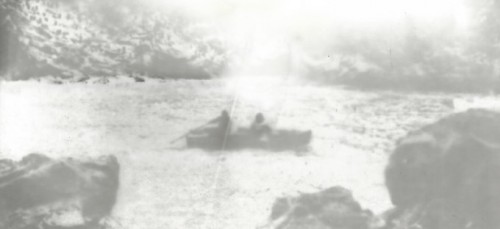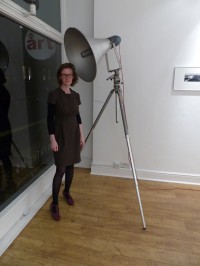
Anaïs Tondeur in collaboration with Jean-Marc Chomaz, Paul Syrillin, 2014, shadowgram, 11 × 24 cm. Image courtesy of the artist and GV Art gallery.
By Margaret Harris
The story of Nuuk began in the early 18th century when a French naval officer landed on a barren, ice-covered island and noted its coordinates in his logbook. The island, he reported, was volcanic in nature, but little else was known about it; indeed, later visitors to its supposed location found no sign of land. Rediscovered in the 20th century, Nuuk was soon visited by a series of scientific expeditions, one of which noted that the island’s surface area was shrinking. An observation station was set up on a prominent headland, but in 2012, it abruptly ceased transmitting; satellite images later revealed that Nuuk had vanished entirely beneath the ocean surface. Coincidentally, the final signal from Nuuk arrived just as the 34th International Geological Congress was meeting in Australia to discuss the emergence of a new, human-influenced geological age: the Anthropocene.
Nuuk and the various forces that contributed to its demise are the subject of a fascinating exhibition currently on show (until 29 November) at the GV Art gallery in London. Lost in Fathoms is a collaboration between an artist, Anaïs Tondeur, and a physicist, Jean-Marc Chomaz, who specializes in fluid dynamics. To develop her ideas about Nuuk, Tondeur spent a year in residence at Chomaz’s Laboratoire d’Hydrodynamique at the Ecole Polytechnique in France, while other parts of the exhibition grew out of a summer school in Cambridge, UK, that focused on fluid dynamics, sustainability and the environment.
The exhibition begins with a series of black-and-white shadowgrams that reconstruct key moments in Nuuk’s history, from its discovery to the instant it vanished beneath the waves. Tondeur, who kindly gave me a tour of the exhibition earlier this week, says she is inspired by early photographic techniques, and the dreamy, inexact quality of her shadowgrams is indeed reminiscent of daguerreotype photographs of the 1830s and 1840s. The image above, for example, represents the first recorded visit to the island, and as I stood in front of it, it was almost possible to believe I was looking at a genuine artefact of the heroic age of exploration – a lost slide from S A Andree’s doomed polar expedition, perhaps.

Anaïs Tondeur stands next to her audio installation Recording from the wandering plates at the GV Art gallery in London.
In the lower floor of the gallery, the story of Nuuk takes a more scientific turn. Among the installations here is a mesmerizing video piece, Echogram Series I Singular Occurrence of a Fall, that depicts the slow-motion collapse of a heap of rough salt. This laboratory-scale echo of landslides and earthquakes reminds visitors that while most geologic processes – the weathering of rocks, the drift of continents – are slow relative to a human lifetime, the planet’s history is also marked by sharp changes. If half a mountain can subside in an afternoon, it seems to say, perhaps the slow-motion disappearance of an island called Nuuk is also within the realm of possibility.
Many of the artworks in this part of the exhibition would not look out of place in a geophysics or hydrology lab. Of particular interest to physicists is MOC Waterdive, in which the surface of a large tank of water is periodically struck by a sound wave. The tank contains both salt and fresh water, and if left to its own devices, it would stratify, with the denser salt water sinking to the bottom. The sound waves disrupt this process, sending writhing pulses of fresh water plunging into the depths and creating chaotic patterns as the different types of water mix together. An accompanying panel explains that in the oceans, this mixing process is part of the “thermohaline circulation” – the immense current that moves water around the globe and, in doing so, helps to create the Earth’s climate.
Could a volcanic island like Nuuk have fallen victim to the same geologic forces that created it? Were its sinking remnants pulled under by powerful current – a current strengthened, perhaps, by climatic changes brought about by human interventions? I won’t spoil it by revealing the answer, except to say that although the story of Nuuk is not entirely what it seems, the results of a final expedition to it were both scientifically plausible and artistically consistent with the rest of Lost in Fathoms – a curiously beautiful meditation on what it means to be a human being, and a scientist, in a fragile and changing world.
Huh? What is this? I’m looking at something called lost in fathoms and it says this:
Nuuk Island occupied a fictional territory. It had been found by chance, in a reflection, in the middle of time…
Despite its modest size, the island was a headland. From there, one could look upon reality…
Was the disappearance of Nuuk Island also the result of a temporal singularity, a collision between the timescale of mankind and that of the oceans or continental drift?
When I search for Nuuk Island, all I get is more reportage of what is obviously a press release. Is this some kind of global warming artwork propaganda spoof? Only in case nobody noticed, people are dying in New York State.
Trackback: Imagination as muse | Artists And Climate Change
Nuuk is the capital of Greenland. In the main Eskimo language, the one spoken in Greenland, it means isthmus. Nuuk Island is a piece of art.
Trackback: Imagination as muse | The CSPA